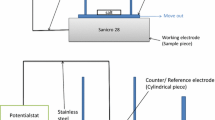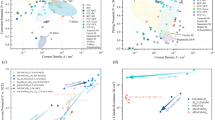Abstract
Since it was first proposed in the early 1980s, Type II hot corrosion has been widely cited in the literature as a process of molten sulfate attack on high-temperature alloy components. In the current study, typical Type II corrosion pits observed on field components were characterized using high-resolution TEM technique. The corrosion products in the pits were found to be mainly of nanosized sulfides and oxides, but not of the hypothesized sulfates. The results suggest a solid-phase corrosion process involving the cooperative precipitation of fine sulfides and oxides at the corrosion front.









Similar content being viewed by others
References
J. Stringer, Annual Review of Materials Research 1976, vol. 7, p. 477–509.
Bornstein N.S. Journal of Metals 1996, vol. 11, p. 37–39.
Pettit F, Oxidation of Metals 2011, vol. 76, p. 1–21.
K.L. Luthra: Metall. Trans., 1982, vol. 13A, pp. 1647–54, 1853–64.
N.S. Bornstein and M.A. DeCrescente: Metall. Trans., 1971, pp. 2875–83.
J.A. Goebel and F.S. Pettit: Metall. Trans., 1970, pp. 1943–54.
K.T. Chiang, F.S. Pettit, and G.H. Meier: in High Temperature Corrosion, NACE-6, R.A. Rapp, ed., Houston, 1981, pp. 519–30.
Lillerud KP, Kofstad P, Oxidation of Metals 1984, vol. 21, pp. 233–70.
Lortrakul P, Trice RW, Trumble KP, Dayananda MA, Corrosion Science 2014, vol. 80, pp. 408–15.
Sumner J, Encinas-Oropesa A, Simms NJ, Nicholls JR, Oxidation of Metals 2013, vol. 80, pp. 553–63.
Haight H, Potter A, Sumner J, Gray S, Oxidation of Metals 2015, vol. 84, pp. 607–19.
Gheno T and Gleeson B, Oxidation of Metals 2015, vol. 84, pp. 567–84.
Gheno T, Azar MZ, Heuer AH, Gleeson B, Corrosion Science 2015, vol. 10, p. 32–46.
Task MN, Gleeson B, Pettit FS, Meier GH, Oxidation of Metals 2013, vol. 80, pp. 541–52.
C.S. Giggins and F.S. Pettit: Hot Corrosion Degradation of Metals and Alloys—A Unified Theory, PWA Report No. FR-11545, 1979, pp. 1–65.
Rapp RA, Corrosion Science 2002, vol. 44, pp. 209–21.
Author information
Authors and Affiliations
Corresponding author
Additional information
Manuscript submitted March 12, 2018.
Rights and permissions
About this article
Cite this article
Zhang, WJ., Sharghi-Moshtaghin, R. Revisit the Type II Corrosion Mechanism. Metall Mater Trans A 49, 4362–4372 (2018). https://doi.org/10.1007/s11661-018-4755-4
Received:
Published:
Issue Date:
DOI: https://doi.org/10.1007/s11661-018-4755-4




